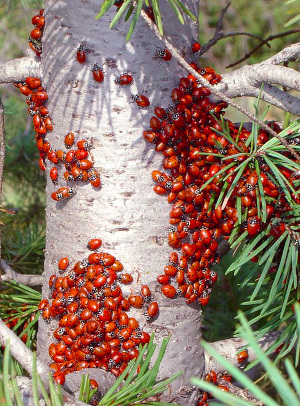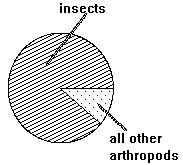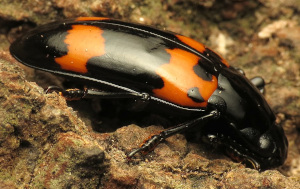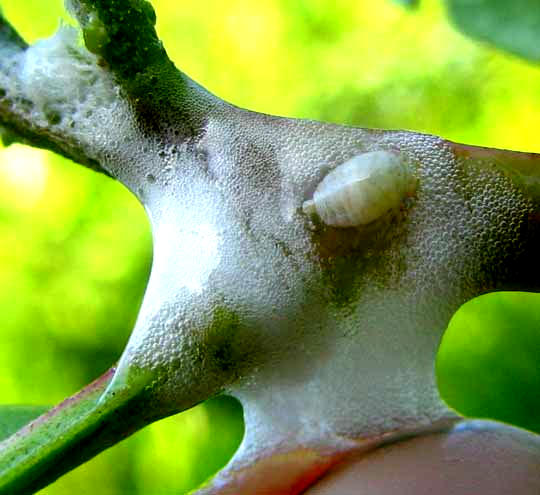 Ladybugs in Colorado; image by BT Denyer via Wikimedia Commons
Ladybugs in Colorado; image by BT Denyer via Wikimedia CommonsIn a typical backyard it's possible to find a greater number of insect species living in more diverse and surprising ways than would be found among all other animal and plant groups. For instance, if for your whole life you look for birds in your local area, which may include parks and refuges, you'll amass a Life List of maybe 300 or so bird species. Similarly, a list of all flowering plant species found in a typical U.S. county might contain only between 500 and a thousand names. However, if you were to list all of a county's insect species, you'd end up with thousands of names. Just in the USA about 91,000 insect species are know, with maybe 73,000 still to be discovered. For more information about insect numbers a good Web page to visit is the Smithsonian's Numbers of Insects page.
 If you thumb through an insect field guide such as Borror and White's A Field Guide to Insects: America North of Mexico, you'll find many insect groups you may have never even heard of. There are barklice, graybacks, clubtails, darners, biddies, toad bugs, velvety shore bugs, ripple bugs, jumping ground bugs, minute pirate bugs, scentless plant bugs, cixiid planthoppers, ensign coccids...
If you thumb through an insect field guide such as Borror and White's A Field Guide to Insects: America North of Mexico, you'll find many insect groups you may have never even heard of. There are barklice, graybacks, clubtails, darners, biddies, toad bugs, velvety shore bugs, ripple bugs, jumping ground bugs, minute pirate bugs, scentless plant bugs, cixiid planthoppers, ensign coccids...
The mind-boggling thing is that all the obscure insect names just mentioned are not names of individual insect species, but rather names of entire insect families. From the viewpoint of classification, when we speak of "jumping ground bugs," it's equivalent to speaking of a plant family such as the lily family or the mustard family, each embracing numerous genera and species.
Though far fewer insect species turn up in the average backyard than in more natural areas, you'll be surprised at the large number that do. Let's say that a couple of summers ago an inch-thick tree limb fell onto the lawn and, instead of picking it up and shipping it to the local landfill, you kicked it out of sight to beneath the hedge.
 Megalodacne heros, Pleasing Fungus Beetle, in Washington, DC, USA. Image by Katja Schulz via Wikimedia Commons
Megalodacne heros, Pleasing Fungus Beetle, in Washington, DC, USA. Image by Katja Schulz via Wikimedia CommonsSimilarly, in the garden, if you spot a weed stem adorned with a gob of bubbly stuff looking as if someone had spit there, and you're brave enough to peep inside the spit, you may find the nymphal stage of a froghopper, or spittlebug, of the family Cercopidae. The "spit" is actually the little nymph's defense against predators who might eat it, if somehow they could see it through the spume.

Such remarkable discoveries are possible in average backyards because tiny bugs occupy tiny niches. The habitat of a spittlebug, shown at the left, is an herbaceous plant's stem, and the spittlebug doesn't worry whether the plant grows in an opening in the forest, or a crack in the sidewalk. In short, to insects, the average backyard is an ecosystem offering thousands of discreet habitats for thousands of discreet insect species.
In fact, there are so many insects that it's hard for backyard naturalists to identify many of them, and sometimes it's impossible. This is true of all insect groups except maybe the butterflies and sometimes the moths. This means that, except for a handful of well known insects, and the butterflies, backyard naturalists very often must be content with determining which family the discovery belongs to. If the genus can be determined, that's spectacular. And if it's an uncommon insect you can identify to species level, then that's just outrageously good.
Therefore, how do we proceed with insects... ?
A good first step is to acquire a field guide to the insects, even though you know that any guide handy enough to carry in the field is not going to include a great many insect discoveries you're going to meet. However, even an incomplete field guide can help you learn the most common species, genera, families, and orders, and the life-cycle features common to those groupings. And getting all that straight is fun. Don't forget our Insect Orders Page.